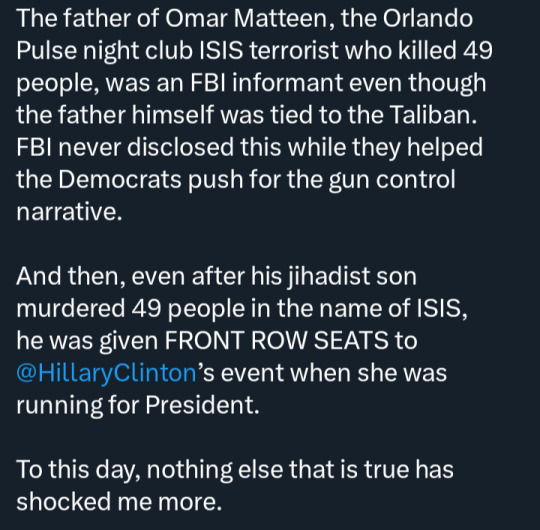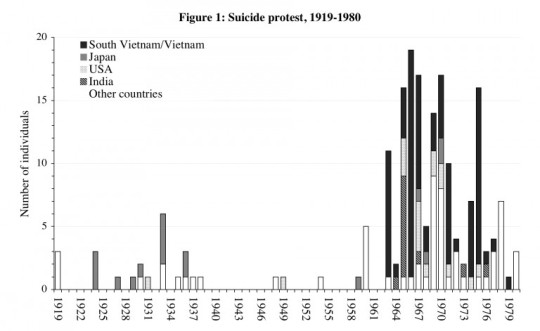#Omar Matteen
Text
From the Memory Hole



84 notes
·
View notes
Photo

Is mass murder now part of the repertoire of contention?
By Lisa Wade, PhD
If there’s one thing Americans can agree upon, it might be that people shouldn’t be indiscriminately firing guns crowds, no matter how angry they are. The shooting in the Ft. Lauderdale airport is just the latest example. Mass shootings are on the rise and I’m fearful that what we are seeing isn’t just an increase in violence, but the rise of a new habit, a behavior that is widely recognized as a way to express an objection to the way things are.
To register an objection to something about the world, a person or group needs to engage in an action that other people recognize as a form of protest. We know, in other words, what protest looks like. It’s a strike, a rally, a march, a sit-in, a boycott. These are all recognizable ways in which individuals and groups can stake a political claim, whereas other group activities — a picnic, a group bike ride, singing together — are not obviously so. To describe this set of protest-related tools, the sociologist Charles Tilly coined the phrase “repertoire of contention.” Activists have a stock of actions to draw from when they want to make a statement that others will understand.
A culture’s repertoire of contention is in constant evolution. Each tool has to be invented and conceptually linked to the idea of protest before it can play this role. The sit-in, for example, was invented during the early civil rights movement. When African American activists and their allies occupied white-only restaurants, bringing lunch counters to a halt to bring attention to the exclusion of black people, they introduced a new way of registering an objection to the status quo, one that almost anyone would recognize today.
New ways of protesting are being invented every day: the hashtag, the hacktivist, and shutting down freeways are some newer ones. Some become part of the repertoire. Consider the header image by sociologist Michael Biggs, which shows how suicide as a form of protest “caught on” in the 1960s.
I am afraid that mass murder has become part of the repertoire of contention. This is theoretically tricky – others have fought over what really counts as a social movement action – but it does seem quite clear that mass murder with a gun is a more familiar and more easily conceptualized way of expressing one’s discontent and then it was, say, pre-Columbine. If a person is outraged by some state of affairs, mass killing is a readily available way to express that outrage both technically (thanks to gun regulation) and cognitively (because it is now part of the recognized repertoire).
Dylann Roof wanted to register his discontent with the place of black people in American society, Robert Lewis Dear stormed a Planned Parenthood with a pro-choice message, Elliot Rodgers was angry about women’s freedom to reject him, Omar Matteen killed dozens to express his (internalized) disgust for homosexuality, Gavin Long communicated his sense of rage and helplessness in the face of black death by killing police. At some point each thought, “What can I do to make a difference?” And mass murder came to mind.
In the aftermath of such events, the news media routine contributes to the idea that mass murder is a form of protest by searching for an explanation above and beyond the desire to kill. That explanation often positions the rationale for the murder within the realm of politics, whether we call it terrorism, resistance, or prejudice. This further sends the message that mass murder is political, part of the American repertoire of contention.
The terrifying part is that once protest tools become part of the repertoire, they are diffused across movements and throughout society. It’s no longer just civil rights activists who use the sit-in; any and all activists do. Perhaps that’s why we see such a range of motivations among these mass murderers. It has become an obvious way to express an objection that the discontented can be sure others will understand.
Lisa Wade, PhD is a professor at Occidental College. She is the author of American Hookup, a book about college sexual culture, and a textbook about gender. You can follow her on Twitter, Facebook, and Instagram.
72 notes
·
View notes
Text
Informe ofreció nuevos detalles sobre la masacre en discoteca Pulse
Estados Unidos.- Casi la mitad de las 49 víctimas de la masacre de la discoteca Pulse murieron en la pista de baile y no tuvieron oportunidad de reaccionar ni correr en busca de auxilio.
Otras 13 personas murieron en los baños mientras esperaban ayuda durante aquella crisis de rehenes que duró alrededor de tres horas. Las revelaciones están contenidas en el informe que cuenta con 78 páginas y que fue entregado por el jefe de la policía de Orlando, John Mina, a unos 10 grupos policiales para examinar la reacción del departamento frente al ataque, considerado el más cruento en la historia moderna de Estados Unidos.
El periódico Orlando Sentinel obtuvo una copia de este documento que incluye diagramas y fotografías tomadas de las grabaciones de las cámaras que llevaban los agentes en sus cuerpos durante su confrontación inicial con el agresor Omar Mateen, cuando acudieron al club a las 2:02 de la mañana del 12 de junio.
En las imágenes se observó al agente Adam Gruler, quien estaba fuera de servicio pero se encontraba trabajando para Pulse aquella madrugada, cuando disparó contra Matteen en la puerta del club.
El funcionario emitió a la policía el código 43, que significa que un oficial necesita ayuda; pocos minutos después, cuando llegaron los refuerzos, Gruler gritó que el individuo se encontraba en el patio y disparó varias veces contra Mateen.
Las imágenes del video que mostraba el interior del club captaron el momento en el que Mateen corrió desde la pista principal hacia los baños del local persiguiendo a los jóvenes que trataban de resguardarse.
Nueve personas fueron asesinadas en los sanitarios ubicados en el flanco norte de Pulse, donde Mateen, de 29 años, se atrincheró durante gran parte de la crisis, según reveló el informe policial. Cuatro personas más perdieron la vida en los baños que se encontraban en el lado sur.
A las 5:02 de la mañana, unas tres horas después de su llegada, la policía utilizó explosivos para ingresar en el inmueble y fue justo cuando Mateen fue abatido en un intercambio de fuego.
En su exposición, Mina destacó que los agentes rescataron personas durante la noche y dijo que desconocía si algunas víctimas fueron alcanzadas por disparos de la policía. El Departamento de Policía de Orlando fue una de las 27 agencias que acudieron al lugar donde ocurrió esta masacre que dejó, además de los muertos, un total de 68 heridos.
0 notes